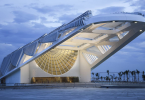As global warming and climate change increasingly enter public consciousness and impact public life, sustainability and eco-friendly living ways are emerging. Whether through the increasingly popular zero-waste lifestyle or using renewable energy like solar panels, humanity is continually making micro strides towards a more ecologically conscious way of life. Especially amid the COVID-19 pandemic, the increasing need for cleaner air and water to maintain basic hygiene means we need to take better care of our environments.
(Source: Green Money)
This shift in the public’s comprehension of our climate crisis has impacted the real estate industry. Builders are more conscious of creating sustainable real estate (also called green real estate). Buildings and construction centers continue consuming one-third of the world’s energy while contributing 40% of global CO2 emissions. Such statistics have led architects to reconsider their designs, pushing for a more sustainable building process, instead.
How to Build Sustainable Real Estate
Making buildings energy efficient reduces their carbon footprints drastically. This remains the primary goal of builders across the world. Investing in eco-friendly living is more than just planting a garden or creating green spaces. While these are vital to keeping the air toxin-free, several aspects of the building require consideration to build a green building truly.
LED Lighting
LED lights are slowly replacing filament bulbs as the primary sources of light within a house. LED lights can add an atmospheric glow, and you can adjust the intensity of the light to your specifications. The fact that they enormously reduce your carbon footprint is simply the cherry on top. Therefore, they are becoming a favorite among sustainable real estate builders today. They are sleek, modern features that add elegance and eco-friendliness to every home.
Vegetable Gardens and Orchards
Building homes with expansive backyards for gardening and growing your greens is also on the rise. This not only provides a breath of fresh air but having greenery around you has been proven to calm residents down. Additionally, you can grow your fruits and vegetables untouched by any pesticides or other foreign bodies. You get all your nutrients while maintaining an ecosystem.
Insulating the Walls and Floors
(Source: Green Passive Solar Magazine)
Insulation is a huge part of building design that regulates indoor temperatures. It is well-documented that air conditioning and other such temperature regulating machinery adversely impacts the environment. Additionally, they also drive up electricity costs. Well-constructed insulation is a solution to this – ensuring that the indoor temperature stays leveled regardless of the outdoors.
Solar Energy and Rainwater Harvesting
Solar panels are slowly making their way into everyday use. The cost of purchasing solar panels has come down significantly since they were first introduced as a result. Along with rainwater harvesting – i.e., reusing rainwater for drinking and bathing purposes – solar energy is one of the most energy-efficient methods of building sustainable real estate. Unlike fuel-based energy sources, solar energy has a negligible environmental impact while remaining robust and sustaining your home. Rainwater harvesting, similarly, allows the continuously-depleting underground water table to replenish while being your primary source of water. It can also help bring back the water table, therefore reducing the temperature of the Earth.
Green Roofs and Walls
Covering the roof with a lawn or the walls with greens is becoming more and more common. This type of sustainable real estate provides a cooling effect and natural insulation and looks very aesthetically pleasing. As we mentioned earlier, greenery has a naturally calming effect. Therefore, green roofs and walls help prevent you from both heat and stress-induced strokes.
Using Locally-Sourced Building Materials
Several sustainable real estate experts advocate for the use of local resources. This cuts down on possible pollution during the transportation of building materials. It also promotes local businesses and encourages homes to be build using available resources. This ensures that the materials are climate-appropriate and have a much lower environmental impact.
(Source: Daily Green World)
Looking Forward
These are just a few sustainable real estate trends that have emerged during COVID-19 and are here to stay. Whether in terms of energy efficiency or aesthetic value, the benefits of eco-friendly living cannot be underplayed.
More people are switching to homes that are environmentally conscious because of better air quality. Builders are answering to these demands and creating more environmentally-friendly homes. Additionally, grading criteria like the US Green Building Council’s LEED program give real estate agencies the push to continue sustainable real estate design today.








